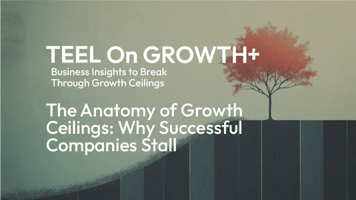From cultural gaps to high-performance subsidiaries: A practical framework for foreign executives...
Stuck at USD 25M? Use the VCOM to Break the Scalability Barrier
A step-by-step case showing how the VCOM solves leadership, process, and execution breakdowns
Executive Briefing
At some point between USD 20M and 50M in revenue, many mid-market companies stall—not because they’ve run out of market, but because they’ve outgrown their internal structure. What worked at USD 5M no longer scales. Leadership gets stretched, processes start to break, decision-making slows, and margins stall despite revenue growth. This article presents a real-world simulation of how to apply the Teel Value Chain Optimization Model (VCOM)™ to one of the most common growth barriers: scalability limitations.
We explore the case of a company stuck at USD 25 million. Despite steady sales, profitability is inconsistent, employee turnover is rising, and the CEO is still too involved in tactical execution. Using the VCOM, we walk through a four-part analysis to identify internal breakdowns across leadership, processes, financial strategy, and execution systems. Each section outlines the specific tactics a leadership team can implement to restore strategic focus, remove operational bottlenecks, and build toward scalable growth.
This simulation demonstrates that scaling is not about working harder or adding headcount—it’s about structurally evolving the business to handle greater complexity with less friction. The VCOM provides a practical, actionable framework for diagnosing where a company is stuck and fixing it at the root.
Whether you're leading a business through a plateau or trying to prevent one, this article offers a clear blueprint for using structure—not intuition—to scale with precision.
NOT LONG AGO, I sat across from a CEO whose company had just crossed USD 25 million in revenue. On paper, everything looked fine—growth continued, sales were up, and headcount had expanded. But behind the scenes, nothing felt scalable. The CEO was in too many decisions. The leadership team was underwater. Margins were flat despite top-line growth. “I feel like I’m dragging this thing uphill,” he told me. He wasn’t wrong.
Most mid-market companies don’t stall because they run out of market. They stall because the internal systems, roles, and routines that worked at USD 5M—or even 15M—break down somewhere between 25M and 50M. And often, the leadership team doesn’t realize it until profitability flatlines, execution slows, or top talent walks out the door.
This article shows what it looks like to apply the Teel Value Chain Optimization Model (VCOM)™ in a real-world scenario: a company stuck at a USD 25 million ceiling. We’ll walk through the common symptoms, explain the underlying causes, and demonstrate how CxOs can use the VCOM to identify internal misalignments, develop targeted solutions, and scale with intention—not improvisation.
Scaling isn’t about effort. It’s about structure. And this simulation shows you how to get it right.
Simulation: The VCOM in Action
Context:
The company is currently plateauing at USD 25 million in revenue and struggling to break through to the next level. Leadership is stretched, execution is slow, and internal systems are showing strain. Profitability is stagnant despite continued top-line growth—classic signs that the business is constrained by scalability issues.
Growth Barrier: Scalability Limitations
Common Signs:
-
Inconsistent Profitability – Revenue is growing, but margins remain flat or declining, indicating inefficiencies that erode value.
-
Leadership Bottlenecks – The CEO or leadership team is making too many tactical decisions, limiting scalability.
-
Scalability Gaps – Processes that supported at USD 5M in revenue break down on the path to 50M.
-
High Employee Turnover – Talented employees leave due to inefficiencies and lack of growth opportunities, often because their psychological needs—such as autonomy, competence, and relatedness—are not being met [1].
-
Slow Decision-Making – Bureaucratic approvals and poor cross-functional collaboration stall execution [2].
The Business Impact:
Unchecked, scalability limitations lead to compounding dysfunction:
-
Revenue stalls and margin compression as operational complexity outpaces execution capacity
-
Workflow breakdowns that impact delivery speed and quality
-
Leadership burnout, with executives mired in day-to-day problem solving
-
Investor skepticism around operational maturity and scale-readiness
-
Loss of talent as high performers leave for better-structured organizations
Companies that address scalability barriers early are significantly more likely to maintain profitability and grow beyond mid-market plateaus.
Applying the VCOM: Step-by-Step Analysis
1. People + Alignment — Strengthening Leadership
At USD 25 million, founder-centric leadership models hit a ceiling. Scaling requires distributing decision-making authority, clarifying leadership lanes, and empowering next-level managers to act with confidence.
Tactics:
- Shift the CEO’s role from tactical involvement to strategic oversight
- Build a scalable leadership team with clear function ownership
- Introduce structured decision frameworks to reduce dependency on top-level approvals
- Leverage performance data to guide leadership focus

Practical Application: At each revenue stage listed, we’ve defined what leaders should be doing within that stage. For example, founders under USD 5M should be deeply operational. The problem isn’t doing the wrong things—it’s failing to evolve. Most growth stalls happen because the current leadership model, while once effective, becomes outdated as the company graduates to the next revenue stage.
Have each executive—including the CEO—track their time over two weeks, split between tactical and strategic work. Compare it to the expected ratio for your current stage. If you're spending too much time in operations, identify three responsibilities to delegate. This simple exercise becomes a roadmap for shifting leadership behavior, increasing executive capacity, and preparing the organization for its next stage of growth. It’s also a powerful tool for succession planning and role clarity.
2. Processes + Integration — Removing Inefficiencies
Growth exposes process gaps that previously went unnoticed. These gaps slow down execution and create costly handoffs between siloed teams.
Tactics:
- Conduct a growth audit to evaluate financial, structural, and operational scalability
- Eliminate decision bottlenecks by clarifying authority and reducing approval layers
- Evaluate system scalability (finance tools, project management, etc.)
- Improve cross-functional collaboration to break down communication silos
3. Financial Strategy + Metrics — Aligning Profitability with Expansion
Revenue growth without financial discipline creates margin pressure and weakens scalability. Organizations must build profit into their expansion model.
Tactics:
- Align cash flow forecasts with realistic scaling scenarios
- Prioritize profit-driven growth instead of revenue-first metrics
- Introduce KPIs that track both efficiency (e.g., SG&A as % of revenue) and margin strength
4. Operational Execution + Intelligence — Enhancing Scalability
Operational maturity often lags behind growth. Execution models must evolve to support complexity without adding friction.
Tactics:
- Streamline working capital practices to reduce drag
- Automate low-value manual processes to unlock bandwidth
- Reengineer workflows to scale without adding headcount or overhead
5. Customer + Market Focus — Not Applicable
While customer experience and market positioning are always important, this specific growth barrier is internal in nature. The company’s constraint isn’t about product-market fit or customer retention—it’s about internal readiness to scale. The issues lie in structure, leadership, process, and execution, not in how the business engages its market.
Why this matters:
Applying customer-facing tactics in a scenario driven by internal misalignment creates distraction. Until the internal value chain is stabilized, external efforts will struggle to gain leverage.
Simulation Summary
This simulation demonstrates how CxOs can use the Teel Value Chain Optimization Model (VCOM)™ to break down a single critical growth barrier—Scalability Limitations—into a structured analysis with tactical next steps. It allows the executive team to focus precisely on what’s preventing scale, without triggering a full organizational redesign.
Structure Over Struggle
Growth isn’t just about selling more—it’s about building a company that can handle more. The challenges at $25 million aren’t the same as they were at $5 million. If your internal systems, leadership structure, and decision-making routines haven’t evolved, growth will stall—regardless of how strong your sales team or product may be.
The good news? These limitations aren’t mysterious. They’re diagnosable. The VCOM exists because too many mid-market companies were making the same mistake: trying to scale with outdated infrastructure and hoping it would hold.
If the simulation in this article felt familiar—if you recognized the signs in your own company—this isn’t a warning. It’s an opportunity. Use the VCOM to identify your constraint, map it to the right component, and build the next version of your business with intention.
Companies don’t scale by accident. They scale by design.
And design starts now.
References
[1] Gagné, M., & Hewett, R. (2025, February 18). What leaders get wrong about employee motivation. MIT Sloan Management Review, 66(3), 45–57.
[2] Gandhi, S. (2023, October 18). What fast-moving companies do differently. Harvard Business Review.
Copyright © 2025, Charles W. Teel Jr., CPA, LLC. All Rights Reserved.




